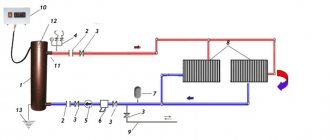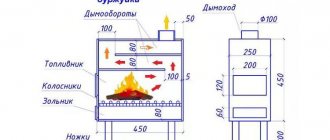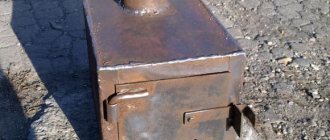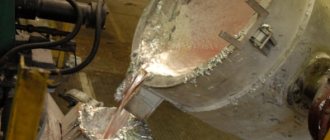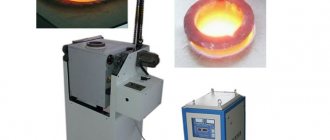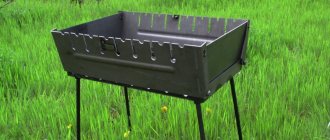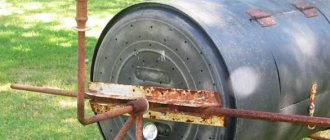Principle of operation
Hot gases, instead of a chimney, enter a special hood, where they burn out (hence the absence of soot). At the same time, the temperature increases even more, and the pressure, on the contrary, decreases. The cycle is constantly repeated and soon the stove reaches the combustion mode with maximum draft (the strength of the latter depends on the design features and quality of installation).
Rocket stove
The temperature in the bell can reach 1200ᵒC, as a result of which all waste burns almost without residue, and the exhaust consists mainly of carbon dioxide and water vapor.
Note! Thanks to this, the chimney can be laid under the floor or through some kind of heating structure (a couch, for example, or a bench). What's more, the hot hood can be used to heat water, cook food, dry fruits, etc.
Jet furnaces
The advantages include:
- high efficiency;
- no soot;
- high temperature;
- the possibility of using cones, damp branches, dry plant stems as fuel - almost everything burns at a temperature of 1200ᵒ;
- low fuel consumption - approximately four times lower than in a standard design.
Types of jet heating devices. Choosing a design for self-production
Craftsmen have developed several designs of rocket stoves suitable for mobile or stationary use:
- portable units made of metal pipes, cans or buckets;
- jet heating devices from a gas cylinder;
- ovens built from fireclay bricks and metal containers;
- heating heat generators with a stove bench.
The most difficult to manufacture are the structures, the construction of which requires the skills of a mason. However, if you have detailed diagrams of serial layouts, even a novice home craftsman can handle this work.
Portable rocket stove
Portable rocket stoves are mass-produced by industry
Hiking options are represented by the simplest designs, which are based on the same pipe bent or welded from individual sections. The improvements affected only the installation of a partition for arranging the ash pit, in which a slot is made for air leakage. Often the lower part of the loading chamber is equipped with a grate to supply air directly to the combustion zone. The opening for storing firewood is equipped with a door, which subsequently regulates the air supply.
The requirements for a mobile design also extend to convenience during cooking, so the upper section of the chimney must be equipped with a stand for metal utensils.
Gas cylinder unit
The use of a gas cylinder is the next step in the development of jet heating devices. A more complex design can significantly increase the thermal power and efficiency of the furnace. All that is required to make the installation is a household gas cylinder or fuel barrel, sections of thick-walled steel pipes and a metal sheet 3–5 mm thick.
A rocket stove made from a gas cylinder can be used to heat small utility rooms
If you have a piece of steel pipe with thick walls and a diameter of more than 30 cm, a rocket stove can be made from it. This option will allow you to avoid labor-intensive operations associated with disassembling the factory gas tank.
How such a design works can be seen in the diagram below. Firewood loaded into the firebox burns due to the flow of air through the loading window. Afterburning of combustible gases occurs in a pipe installed inside the cylinder due to the supply of secondary air. To enhance the effect, the inner chamber is insulated, which makes it possible to raise the temperature inside above 1000 °C. Hot gases hit the bell as they move and enter the outer chamber, the walls of which act as a heat exchanger. Having given up their energy, the combustion products are discharged through a chimney cut into the lower part on the back side of the cylinder.
To create the draft necessary for stable operation of the rocket stove, the top of the chimney is raised at least 4 m relative to the loading window.
Combined rocket stove made of brick and metal barrel
The use of fireclay bricks for arranging the firebox and internal chambers of a jet heating device transforms the “rocket” into the category of stationary structures. The high heat capacity of the materials used allows heat to be accumulated and released within several hours, which is why such units are often installed in residential premises.
Furnace structure with refractory lining of the working area
Jet stove with stove bench
Like other solid fuel stoves, the "rocket" has the disadvantage that most of the heat is lost through the chimney. Despite this, certain advantages of its design make it easy to get rid of this disadvantage. The thing is that the unit was called reactive for a reason, but because of the high rate of excision of burning gases. This feature can be turned into a benefit by significantly increasing the length of the smoke exhaust channels.
Scheme of a jet stove with a stove bench
This idea found its implementation in massive stationary structures with a couch in the shape of a sofa or bed. It is successfully made from brick or rubble stone, decorated with a plastic mass of clay and sawdust. Thanks to the high heat capacity of the materials used, the stove can retain heat all night, which, combined with high efficiency, makes the heating unit very attractive for installation in residential premises.
When choosing a design for manufacturing at home, you need to take into account the features of its operation. As a camping option, choose a mobile unit - it will be enough to warm up, dry clothes and cook lunch. In order to occasionally heat small technical rooms, a portable structure made from a gas cylinder is used. If you need to heat a small country house or cottage, then there is simply no better option than a jet heating unit with a stove bench.
Types of rocket stoves
There are several types of rocket (or jet, as they are also called) stoves.
- Portable structures made from tin containers (paint cans, buckets, etc.). Excellent helpers on a construction site or on a hike, which can be made in just a few hours.
- Furnaces made of refractory bricks and metal barrels, intended for heating heat-intensive masses. They are distinguished by a horizontal chimney installed underground and an external riser to provide draft.
- Completely brick structures are used for air-heated floors. They consist of several chimney pipes at once.
Note! Due to the complexity of implementing the third option, only the first two will be considered in this article.
Stages of construction of brick rocket furnaces
Preparing for work
Construction is best done from fireclay bricks.
To equip rocket-type heating brick structures, the first thing you need to do is to carefully study the construction drawings and diagrams and agree on the dimensions of the surfaces. Ordinary red brick is not suitable for the job; it is better to lay such furnaces with fireclay material that is resistant to high temperatures. At the preparatory stage, a pit up to 50 cm deep is dug in the floor. This is done in order to eliminate the risk of raising the overall horizontal level of the chimney. A steel barrel is used as a cap, which is pre-coated with fire-resistant paint, but after the flange for the chimney outlet is fixed. Necessary materials:
- red brick, fireclay;
- blower and cleaning door;
- hob;
- fire door;
- metal shelf panel for decorating the back;
- asbestos sheet;
- chimney pipe;
- clay;
- sand;
- water.
Laying the foundation
After the preparatory activities, they move on to the next stage. The process of laying the foundation consists of the following points:
For the foundation of the building you need to make formwork.
- The formwork for the base of the structure is formed.
- Taking into account the calculation of the space for the firebox, several bricks are laid in the ground.
- The bottom of the base is covered with steel reinforcement.
- A row of bricks is laid along the perimeter around the combustion chamber, one level at a time.
- The entire surface is filled with concrete.
A rocket stove made of long-burning bricks, despite its simplicity of design, can solve a number of problems for owners of dachas and private houses. These include not only heating and cooking functions, but also the creation of an original interior and comfort in the room.
Collapse
Operating rules for rocket stoves
Rocket stoves, as well as other long-burning designs, need to be launched onto a warm pipe. And if for the second version of the stove this is not so important, then for the first, a cold chimney will only lead to wasted burning of fuel. For this reason, the structure needs to be preheated - heated with sawdust, paper, etc.
Note! Warming up can be considered completed only after the hum changes or subsides altogether. After this, fuel is loaded. There is no need to set it on fire, because it will ignite from the “boosting” fuel.
It is also worth noting that the jet stove is unable to self-adjust, so at first the vent opens completely, and closes only after the structure begins to hum strongly. Subsequently, the availability of oxygen gradually decreases.
About the rocket stove in the bathhouse
Jet wood stove with deck chair
Many people are probably interested in the question: is it possible to use a jet stove in a bathhouse? It would seem that it is possible, because it is quite easy to equip a heater on a tire.
In reality, such a design is not suitable for a bathhouse. For light steam, you first need to warm up the walls, and only then, after some time, the air. For the latter, the oven must be a center of convection and thermal radiation (IR). This is the problem - in a rocket furnace, convection is clearly distributed, and the design does not provide for losses due to thermal radiation at all.
DIY rocket oven
Features of the rocket stove
A jet stove with a stove bench is the most productive option for the home
Despite such wild popularity in the world, in the CIS countries the long-burning jet stove is known only to a few. And this is quite strange, because in some regions of our country the cold lasts for more than six months.
A rocket or jet stove, contrary to its name, does not imply anything supernatural in its design. You won't find any turbines here. But still, in such a design there is something similar to space transport - and this is a flow of flame, characterized by high intensity, as well as a characteristic hum that occurs during operation.
Jet heating stoves are designed extremely simply, but despite this, they use advanced fuel combustion techniques. Let's look at what makes this design so effective:
- The movement of gaseous products through the furnace channels occurs solely due to natural draft. For this reason, forced ejection is not required here.
- The process of pyrolysis resulting from the dry distillation of solid fuel.
Drawings of jet furnaces in their simplest form
Important! The simplest “rocket” design is a large-diameter pipe with a characteristic bend. Moreover, one section of it is shorter than the other. It is installed horizontally and is intended for storing firewood.
Let's look at the furnace operation process in more detail:
- Firewood is placed in the firebox, which is then set on fire.
- Next, the device begins to operate in the mode of a traditional potbelly stove, which continues until the longer vertical part of the stove, which is a chimney, warms up.
- The metal heats up red-hot, resulting in the ignition of flammable substances accumulated in the chimney, at the top of which a rarefaction zone appears.
- The draft is enhanced, providing increased air flow to the firewood. Thanks to this, the efficiency of the combustion process increases significantly.
Drawings of a camp stove Robinson
Advice! To make the jet thrust in the furnace even stronger, the structure should be equipped with a combustion door. It works as follows: when the cross-section of the air channel decreases, the supply of oxygen to the firebox stops. Thus, the traditional combustion process develops into pyrolysis, in which the wood begins to smolder and decompose. At the same time, the process of fuel combustion slows down, and therefore heat is released longer.
- To ensure complete combustion of fuel as a result of pyrolysis, it is necessary to provide a special zone in the furnace, which is intended for afterburning gases. This will be discussed more specifically below, but here it should be noted that, along with thermal insulation of the chimney, such an improvement in the classic “rocket” allows it to successfully compete with modern long-burning installations.
Important! The simplest DIY rocket stove is usually used for heating or cooking food. To do this, you just need to install a special platform on the vertical section of the furnace.
conclusions
Be that as it may, today in the manufacture of rocket stoves there is more intuition than real accurate calculations, therefore, this is an almost limitless field for creativity.
We also suggest that you familiarize yourself with the video instructions for making a rocket stove.
Video - Do-it-yourself jet stove
Similar articles
- Do-it-yourself oven - assembly instructions!
Not long ago, a simple solution to the problem of recycling machine oil appeared. Let us remind you that this oil is used in mechanisms to lubricate individual elements... - DIY brick sauna stove: step-by-step master class with photos.
If you are in the Arkhangelsk region, be sure to go to the local bathhouse. This is something special, unique and very original. The local bathhouse doesn’t… - DIY water pump - instructions!
Despite the affordable cost and wide range of modern pumping equipment, some primitive models can be manufactured...
Outdoor rocket stoves, advantages and disadvantages
On warm summer days, many city residents prefer to spend their free time with friends, family and loved ones at the dacha, country house, or simply have picnics when going out into nature. What would a vacation be without a good feast and delicious, freshly prepared dishes? Of course, you can use a boiling pita at home, or even build a large barbecue oven complex at your dacha - but this is not always convenient, expensive and time consuming. It is much more convenient to use an outdoor oven, which will allow you to easily and quickly prepare various dishes directly in the fresh air, surprise and delight your guests, family and friends with your culinary abilities.
Let's talk about outdoor stoves, and specifically about their variety - rocket-type outdoor stoves, about their features, advantages and possible disadvantages. Let's look at the functionality of such furnaces using the example of a model of a rocket-type furnace - Vesuvius Rocket Soyuz, a well-known Russian manufacturer.
An outdoor rocket-type stove is a stove that operates on the principle of direct combustion, when without forced draft in the chimney, circulation and combustion of house gases occurs in the channels of the stove. At the same time, the power of such a stove is high enough to heat some space and, even more so, to quickly cook food.
The design of a rocket-type stove is quite simple, and many such stoves are made by single craftsmen on their own. Given their simplicity and efficiency at an inexpensive price, rocket type stoves have become popular and are now being produced commercially. Now, in order to purchase such a stove, you do not need to make efforts to make it yourself or turn to individual artisans. Currently, it is possible to buy an outdoor rocket-type stove, manufactured at a factory in an industrial environment, and this stove will be made of durable materials, reliable and have a long service life.
Examples of DIY rocket stoves
DIY rocket stove
DIY rocket stove
Advantages and disadvantages of a rocket type furnace.
Let's look at the features of this type of outdoor stove using the example of the Vesuvius Rocket Soyuz stove model, in comparison with other stoves. It must be said that the manufacturing company Vesuvius studied user reviews and opinions about rocket-type stoves, and design changes were made to this model of outdoor stove to correct shortcomings and improve its ease of use and functionality.
- Some models of outdoor rocket stoves with a large height and small support area are not stable and often tip over, for example, in strong winds. The semi-stationary garden stove Vesuvius Rocket Soyuz does not have this drawback. The oven is equipped with a stand measuring 380x310 cm, which ensures the stability of the structure. The combustion chamber is rigidly connected to the stand, which additionally prevents the garden stove from tipping over;
- When using an outdoor stove, it was necessary to approach it with caution when heating it, since accidental touch could lead to burns. The design of the Vesuvius Rocket Soyuz frame prevents accidental touching of the combustion chamber and causing burns;
- Often, in the manufacture of furnaces in artisanal conditions, inexpensive grades of steel were used that were not intended to operate at high temperatures. All its structural elements of the Vesuvius Rocket Soyuz are made of durable alloyed, heat-resistant steel with a thickness of 2 to 3 mm.
- With rocket-type outdoor ovens, you can use cookware with both flat and rounded bottoms. In particular, the Vesuvius Rocket Soyuz oven is universal in terms of the use of utensils; it comes complete with special mounts and stands for cooking dishes both in a cauldron and in a frying pan;
- On top of the Vesuvius Rocket Soyuz furnace there are special sides made of the same heat-resistant steel. They perform two functions at once in a garden stove. Firstly, they prevent the flame that flared up in the stove from spreading outward, blocking it. In addition, the sides prevent strong wind from penetrating inside the structure - thereby it will not extinguish the fire;
- Economical. This applies primarily to the use of firewood. They are required much less than when cooking on a grill or in a conventional stationary oven. At the same time, the Vesuvius Rocket Soyuz burns both small and long large-sized firewood equally quickly. Their size does not matter - all the material burns quickly and evenly, releasing heat outward.
- With all these advantages, a factory-made outdoor stove is completely inexpensive - you will be pleasantly surprised by its prices;
When purchasing a rocket stove Vesuvius Rocket Soyuz, you are buying a combined product. It combines the stability and reliability of stationary ovens with the lightness and mobility of small format ovens. You can always easily move such a stove to the corner of your garage, barn, or other utility room. Using an outdoor or garden stove, you can pleasantly surprise your friends or relatives by preparing delicious meat, fish or vegetable dishes in the fresh air in a few minutes. Believe me, they will be very grateful to you!
